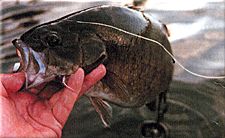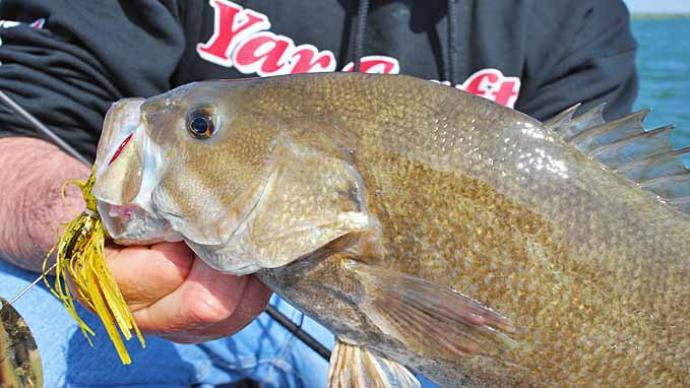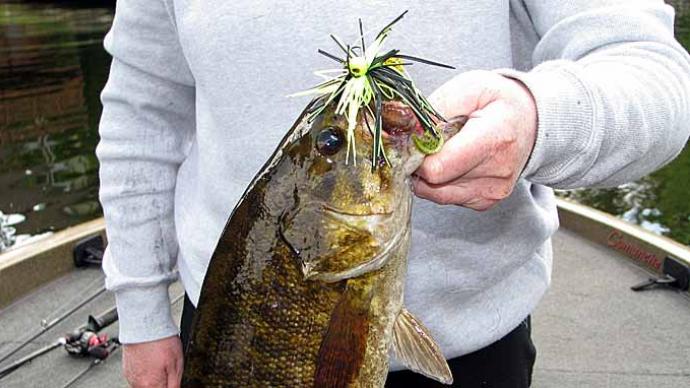
May and June are perhaps the best times to go after smallies, and if you know something about their tendencies and habits in the late spring, there is some great action to be had on many, many lakes.
Similar to largemouth behavior, something magical happens when water temperatures reach 50 degrees; smallies become active and begin to feed, prior to making preparations to move more shallow and spawn.
Certainly, temperature and weather in mountain climates affect the speed with which the water warms and smallies feel comfortable moving shallow. In many mountain environments above around 5000 feet elevation, it can snow in almost any month of the year. And, in most lakes, very predictable winds appear daily, which in early spring, continually mixes the warmer surface water with colder layers from below.
Flaming Gorge is a large reservoir that Wyoming and Utah both share. Bass West has, in the past, published destinations articles and even a few pro columns about the make up of the lake, and how to approach fishing it. But, understanding smallmouth behavior in May and June is the key to enjoying a fishery like "The Gorge" for eight months a year.
Many years, ice covers Flaming Gorge until late April. But, as soon as the ice clears, the water seems to jump up to that magical 50-degree mark. In many largemouth lakes in the springtime, one would immediately look for stained water to find warmer water, and therefore, the first active fish. In most mountain lakes, and especially in Flaming Gorge, there are only a handful of bays and flats that produce stained or off-colored water in the springtime, and even those areas don't produce truly dirty water.
Though the areas of off-colored water are few, the same principal applies to smallies as applies to largemouths. If you can find water just a few degrees warmer because of incoming water, or water stained as a result of wind and wave action, you'll also find some good fish.
Prespawn
Typical prespawn behavior for mountain smallies really doesn't vary too much from lake to lake. Fish will "gang up" in the backs of creeks in the off-colored water, and they will gang up in the back of flats. I noticed over the years that in some lakes like Lake Powell and others, the smallies are more vertically oriented. They seek out the cliff walls, rock slides, and vertical depths. On other lakes, and specifically Flaming Gorge, the smallies tend to gravitate toward the flats, rather than the rock walls or bluffs.
The prespawn period is not a long, drawn out affair. When the water begins to warm, and I believe, because of a shortened growing season for the bass, spawning activity begins very quickly.
We've read about how largemouths get in the prespawn or staging mode sometimes months before the actual spawn. But, mountain smallies don't have that luxury. When they feel it's time, they do their thing, and get on with life.
Smallies look for a hard bottom with small gravel areas generally, although I have seen smallies spawn on pure sand bottoms too. The main difference in identifying typical spawning areas follow the same pattern as I explained before. On Lake Powell, for example, you might look for a bank with boulders strewn along the shore, and find beds in and around those areas. While on Flaming Gorge, you would look to nondescript banks that may have smallish rocks and gravel that extend into the water.
I can't stress enough the differences in the prespawn behaviors of these fish. Rather than being slow to make it into the spawning mode, mountain smallies can begin building nests the very day they move into their prespawn water. If you realize that, you can easily key on the bedding areas and find instant angling success.
Spawn
Unlike largemouths, smallies don't generally range quite so far from staging areas to actual spawning flats and cuts. Smallies gang up on spawning sites just the same way they congregate on flats, creek channels, and cuts in the prespawn period. When you find one nest you'll find a bunch of them. They don't move a long distance to spawn. Most of the time, it's a matter of yards and not long distances smallies travel to make their beds.
Mixed in and among the masses of spawning smallies, are the truly large fish. In mountain lakes, a 3- to 5-pound smallmouth is considered a trophy. The best time to catch the big ones is either just before, during, or just after the spawn.
The spawn doesn't last very long. I've seen bass make their beds, spawn and move off in a matter of a day or two.
Postspawn
The beauty of fishing for smallies in May and June is that all three phases of the spawn happen quickly and in very close proximity to one another. You can readily catch prespawn, spawn and postspawn fish within a relatively short distance, sometimes in less than 50 yards.
Baits
The standard forage for smallmouths on most mountain lakes are crawdads. However, each lake has its own minnow base and in June a good minnow bite usually takes place. On the Gorge, chub minnows become a target sometime in June. And of course, trout is a real favorite of all smallmouths. If the Fish and Game are planting small trout, the smallies gather like pigs to a trough.

Tackle selection this time of year is a pretty short list. I prefer spinning tackle with light monofilament to go after smallies in the late spring, because my three favorite types of baits this time of year are all light-weight or finesse presentations.
A Yamamoto 3-inch grub has to be my number one bait. I swim it on a light 3/16-ounce or 1/4-ounce jig head and it is a great producer.
Next, you should always have a soft jerkbait tied on - a fluke or Senko in the 4-inch size, or a hard jerkbait such as a Luckycraft Pointer minnow, or even a Staysee.
Don't overlook small Bomber-type crankbaits or Shad Raps either. They will all catch smallies in all stages of the spawn, and you won't go wrong with one of them tied on.
One behavioral trait I've learned about smallmouths is that they're almost always looking up. That is why crankbaits, swimming baits, and soft jerkbaits are so deadly.
A good medium to medium/heavy rod is a must, and I like two G-Loomis rods for my smallmouth action. A SJR782 is a good reaction-bait rod, and the 783 is for fishing grubs and tubes. When aggressive springtime smallies attack the bait, having the option to back reel a spinning reel will increase you're landing percentage in a big way.
From Washington to New Mexico, mountain lakes produce great numbers of smallmouth bass. Get to know your favorite lake, and apply some of the things mentioned here. I'm sure you'll agree that some of the best action of the year will happen over May and June.
Reprinted with permission from Bass West Magazine



